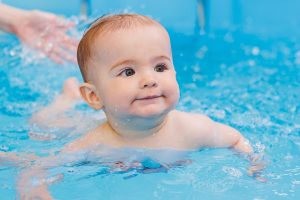Opening your eyes underwater without goggles might seem intimidating, but it’s an essential skill for any swimmer.
Whether you’re learning to swim yourself or helping your child, being able to see underwater builds confidence and improves safety.
Let’s explore how to get comfortable with this skill, address common concerns, and understand why it’s so important.
How to Open Your Eyes Underwater
Opening your eyes underwater can be uncomfortable at first, but with the right approach, you can get used to it. Here are some simple steps to help you practice:
- Start in Clean Water: Choose a pool with clean, chlorinated water or clear freshwater. Avoid murky or overly salty water until you’re comfortable.
- Prepare Yourself: Take a deep breath and relax. Anxiety can make the process harder.
- Submerge Gradually: Dip your face in the water with your eyes closed. Let your face get used to the sensation.
- Squint First: Slightly squint your eyes open underwater to let a little water in. This helps you get used to the feeling.
- Open Fully: Gradually open your eyes wider. Start with a few seconds and increase the duration as you get more comfortable.
- Rinse Your Eyes: Afterward, rinse your eyes with fresh water to reduce irritation. This helps flush out chlorine, salt, or debris.


Can You Open Your Eyes Underwater?
Yes, you can! Most people are capable of opening their eyes underwater, especially in pools or clear lakes.
If it feels uncomfortable, it’s likely due to the initial sensation of water on your eyes.
With consistent practice, you’ll find that this discomfort fades, and the skill becomes second nature.
Is It Okay to Open Your Eyes Underwater?
It’s generally safe to open your eyes underwater, particularly in clean, chlorinated pools or clear freshwater.
While some irritation is normal, it typically goes away quickly. In saltwater, you may feel a bit more stinging, but it’s still safe in short bursts.
However, avoid opening your eyes in murky, polluted, or stagnant water, as this increases the risk of infection.
What Happens When You Open Your Eyes Underwater?
When you open your eyes underwater, your vision will be blurry because water bends light differently than air does. You might experience a mild stinging sensation from chlorine or salt, but this usually passes quickly.
Despite the blurriness, being able to see underwater helps you navigate, avoid obstacles, and maintain balance.
With practice, this becomes a natural part of swimming, making you feel more confident and aware of your surroundings.
Why Can’t I Open My Eyes Underwater?
If you’re struggling to open your eyes underwater, it might be due to a few factors.
Fear or anxiety is a common reason, especially if you’ve had a bad experience before. Eye sensitivity to chlorine or salt can also make it difficult. Sometimes, it’s just a matter of practice – if you haven’t done it before, it might take time for your eyes to adjust.
Start slow and take small steps, and remember to stay relaxed. The more you practice, the easier it becomes.
Read more: Water phobia in babies: How to get over a fear of water?
How to See Underwater Without Goggles
Seeing underwater without goggles takes practice, but it’s achievable. Begin by relaxing and taking a deep breath before dipping your face in the water.
Open your eyes gradually, starting with a squint and working up to fully opening them. You’ll notice that your vision is blurry, but that’s completely normal.
The goal is to see well enough to navigate and stay aware of your surroundings. After your swim, rinse your eyes with fresh water to reduce any irritation.
Why This Skill Matters
Learning to open your eyes underwater without goggles is more than just a neat trick — it’s an important life skill.
In real-life situations, like accidentally falling into a pool or lake, goggles might not be available.
Knowing how to see underwater helps you stay calm, orient yourself, and swim to safety.
Practicing this skill builds confidence, improves balance, and makes you a stronger, more adaptable swimmer.
Take your time, stay patient, and keep practicing. With a little effort, you’ll open up a whole new world of underwater exploration and feel safer in the water.


Read more: A Parent’s Guide to Water Safety for Kids
Our Experience and Insights on This Essential Skill
The first steps in swimming are teaching your child to hold their breath, submerge their head, and open their eyes underwater. Making this fun is key to overcoming fear.
Children familiar with water on their heads from baths or showers tend to adapt more easily. Interestingly, second-born children often embrace this quicker due to playful interactions with older siblings.
Introducing babies to water early – by gently pouring warm water over their heads – helps prevent fear. If your child is hesitant, patience is essential.
Swim instructors can guide them gently. For fearless children, controlled swimming lessons help them understand water safety.
Opening their eyes underwater improves navigation, balance, and confidence.
Though it may feel uncomfortable at first, encouragement and practice help them adjust.
In time, this skill can open up a whole new underwater world for your child and enhance their water safety.
Building Confidence with Shapland Swim Schools
At Shapland Swim Schools, we help children gain confidence by mastering essential skills like opening their eyes underwater.
Our small class sizes and patient instructors provide a safe, supportive environment where kids can learn at their own pace.
With our gentle guidance, your child will build the skills needed to become a confident and capable swimmer.
